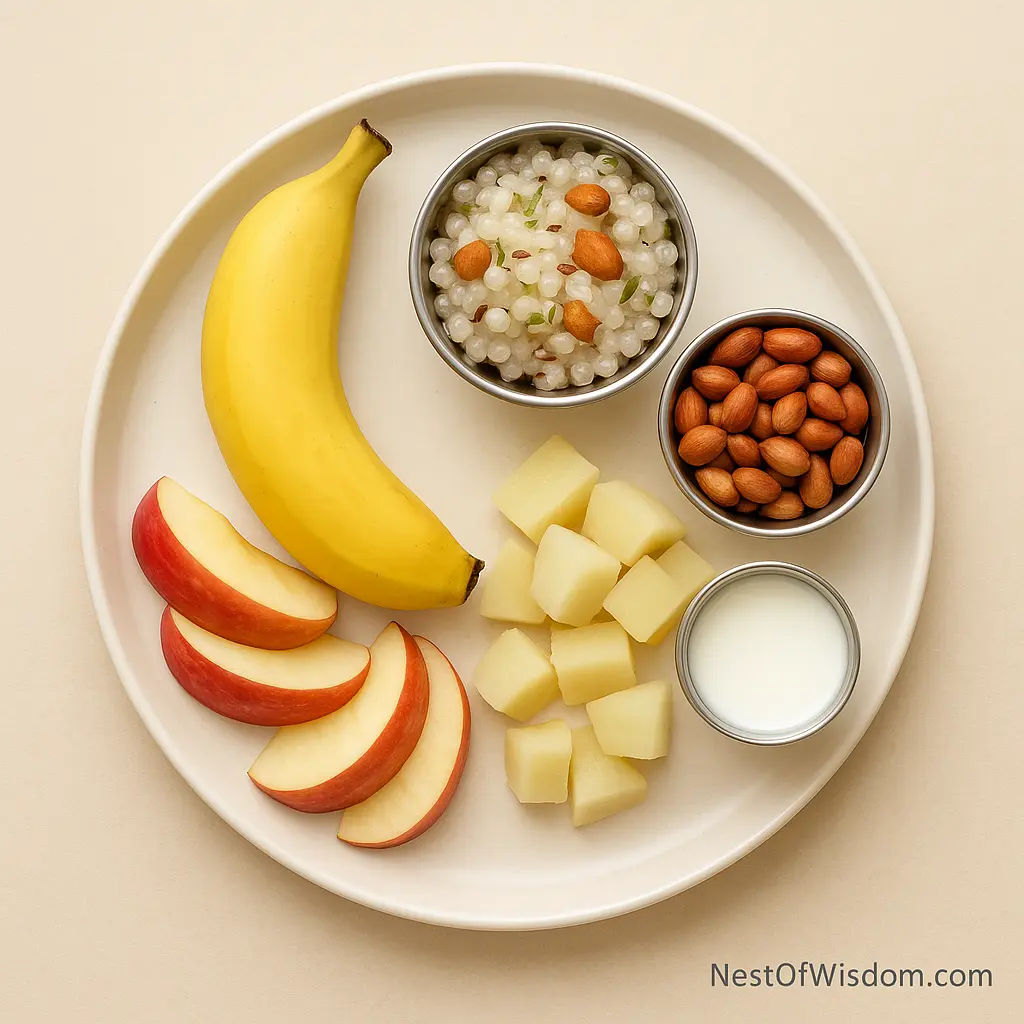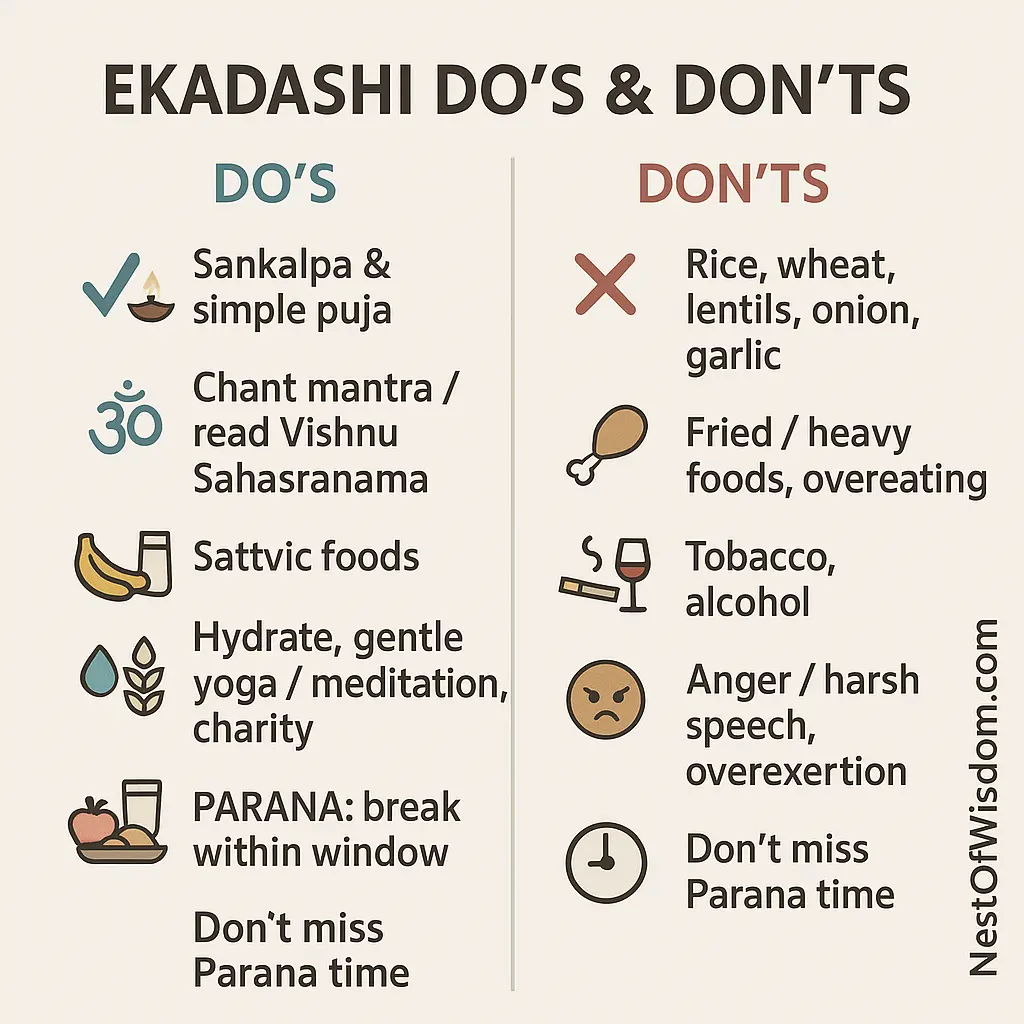Ekadashi is more than a food rule; it is devotion, discipline, and a sacred reset that purifies mind, body, and energy.
Table of Contents
- What is Ekadashi?
- Why Ekadashi Works (Spiritual & Lifestyle Logic)
- 21 Benefits of Ekadashi Fasting
- Day-Before Preparation (Simple & Practical)
- How to Observe Ekadashi (Simple Vidhi)
- Allowed & Avoided Foods (Sattvic Guidance)
- Sample Ekadashi Day Schedules
- Mantras & Bhakti Practices
- Do’s & Don’ts at a Glance
- Parana: How to Break the Fast (Next Morning)
- Popular Ekadashi Types & Meaning
- Common Mistakes & Easy Fixes
- Safety Notes & Who Should Be Careful
- FAQs
- Printable Checklist
- External References
- Final Thoughts


What is Ekadashi?
Ekadashi falls on the 11th lunar day (Tithi) twice every month — once in Shukla Paksha (waxing moon) and once in Krishna Paksha (waning moon). Devotees fast, worship Lord Vishnu, and simplify routine to cultivate inner clarity. The heart of Ekadashi is sattva — a clean, calm, light way of living for one sacred day that resets your rhythm every fortnight. The Benefits of Ekadashi Fasting include devotional focus, steadier emotions, gentler digestion, and a renewed sense of self-control.
Dates and exact Parana windows vary by location; always check a reliable panchang for your city (e.g., DrikPanchang) and follow your family’s tradition.
தமிழில்: எகாதசி நோன்பு மனதை அமைதியாக்கி, பழக்கங்களை சீராக்கி, இறைவனை நினைத்துக் கொள்ள உதவுகிறது. Benefits of Ekadashi Fasting ஆன்மிக ஒழுக்கத்தை உறுதிப்படுத்துகிறது.
Why Ekadashi Works (Spiritual & Lifestyle Logic)
Ekadashi simplifies everything for one day: fewer decisions about food, fewer sensory inputs, and more remembrance of the Divine. That simplicity frees attention for japa, prayer, and service. Biologically, a lighter plate offers gentle digestive rest; psychologically, an intentional vow trains willpower. Together, these forces compound into the lived Benefits of Ekadashi Fasting — clarity, steadiness, and compassion.
- Spiritual cadence: a sacred pulse every two weeks makes devotion a habit, not a mood.
- Attention reclamation: less snacking and scrolling → more japa, study, kirtan.
- Emotional regulation: calm foods + calm speech reduce friction at home and work.
- Discipline training: keeping one promise repeatedly strengthens the mind.
தமிழில்: நோன்பின் எளிமை மனதைப் பாதுகாக்கிறது; இதுவே Benefits of Ekadashi Fasting பெருகச் செய்கிறது.
21 Benefits of Ekadashi Fasting
Observed sincerely and completed properly with Parana, the Benefits of Ekadashi Fasting are both immediate and cumulative:
- Inner quietude: fewer stimuli, more mantra and reflection.
- Devotional depth: remembrance of Lord Vishnu throughout the day.
- Stronger willpower: practicing “no” with love, not force.
- Routine reset: a fortnightly pause that gently reorganizes life.
- Lightness in body: sattvic choices soothe digestion.
- Sharper focus: fewer food decisions, more attention for purpose.
- Gratitude & charity: share fruits or simple prasada with others.
- Hydration awareness: mindful water/herbal drinks if not on nirjala.
- Reduced late-night eating: sleep supports spiritual practice.
- Kind speech: a day to avoid anger, sarcasm, and gossip.
- Family bonding: collective puja and simple cooking.
- Financial temperance: avoid excess; spend mindfully.
- Cleaner palate: cravings soften; comfort foods lose grip.
- Emotional balance: mantra steadies the nervous system.
- Gentle detox support: a break from heavy, oily meals.
- Rhythmic discipline: the cycle reinforces consistency.
- Clear intention: a written sankalpa guides the day.
- Less screen time: swap doom-scrolling for recitation.
- Community harmony: volunteer or offer annadanam.
- Spiritual confidence: keeping vows builds self-trust.
- Long-term balance: steady practice makes the Benefits of Ekadashi Fasting visible month after month.
Day-Before Preparation (Simple & Practical)
- Choose your pattern: phalahar (fruits/milk), light sattvic plates, or a stricter fast as per family tradition.
- Shop & prep: fruits, sabudana, rock salt, peanuts, milk, tulsi, diya wicks, ghee/oil.
- Set reminders: Parana window alarm for Dwadashi morning; keep water ready.
- Write your sankalpa: one sentence of intention; place it near your altar.
- Sleep early: a calm night multiplies the Benefits of Ekadashi Fasting.
தமிழில்: “முன் நாளே தயார் செய்தால் எகாதசி நாள் எளிதாக இருக்கும்; மன அமைதி அதிகரிக்கும்.”
How to Observe Ekadashi (Simple Vidhi)
The Benefits of Ekadashi Fasting are strongest when devotion and practicality move together. Keep it simple and sincere:
- Pre-dawn: bath, clean clothes, light a diya, place a small image/coin of Lord Vishnu, write and speak your sankalpa.
- Morning: chant Om Namo Narayanaya or read a few verses of Vishnu Sahasranama; offer tulsi and gratitude.
- Daytime: choose fruits/milk/sabudana/potato if not on a strict fast; avoid grains and fried foods; hydrate mindfully.
- Evening: short puja, bhajan, or quiet reading; practice gentle speech and kindness.
- Next morning (Dwadashi): complete the vow with Parana in the prescribed window.


தமிழில்: “ஸங்கல்பம் தெளிவாகக் கூறி, நாள் முழுவதும் எளிமையாக, அமைதியாக நடந்து கொள்ளுங்கள்; அப்படியானால் Benefits of Ekadashi Fasting இயல்பாகவே கிடைக்கும்.”
Explore weekday fasts too: Monday (Somvar) Vrat, Tuesday (Mangalvar) Vrat, Wednesday (Budhvar) Vrat, and Friday (Shukravar) Vrat.
Allowed & Avoided Foods (Sattvic Guidance)
Traditionally, grains and lentils are avoided on Ekadashi. Families choose patterns that protect health while supporting prayer — from fruit-based fasting to very light sattvic plates. Choose the simplest plan that preserves your steadiness and honors your lineage. The Benefits of Ekadashi Fasting grow when food is clean, portions are small, and the mind is gentle.


Commonly Included (varies by family)
- Fruits, fresh juices (unsweetened), coconut water
- Milk, buttermilk, yogurt (if it suits you)
- Sabudana, potato, sweet potato; small portions of peanuts or cashews
- Rock salt (sendha namak) and gentle spices
Generally Avoided
- Rice, wheat, other grains, and lentils
- Onion, garlic; heavy chilies; deep-fried foods
- Alcohol, tobacco, stimulants
தமிழில்: “அதிக எண்ணெய், காரம், மா வகைகள் அனைத்தையும் தவிர்த்து, பழங்கள், பால், சபுதானா போன்ற எளிய உணவுகள் பாதுகாப்பாக இருக்கும்.”
For moon-phase observances beyond Ekadashi, see our guide to Pournami / Amavasya Fasting and browse all Fasting Rituals.
Sample Ekadashi Day Schedules
1) Phalahar (Fruits/Milk) — Classic & Gentle
- Pre-dawn: puja + sankalpa; water or warm milk.
- Breakfast: banana + a few soaked peanuts; coconut water.
- Lunch: small sabudana preparation or fruit bowl.
- Evening: bhajan + warm milk; early sleep.
2) Working Day — Light Plates & Steady Focus
- Pack fruits, nuts (small portion), and rock-salt buttermilk.
- Block 10 mins for mantra breaks; avoid social media dips.
- Keep calls calm; speak slowly; protect the Benefits of Ekadashi Fasting.
3) Family-Friendly — Shared Simplicity
- Do puja together; one reads, one lights diya, children offer tulsi.
- Keep a simple kirtan playlist in the home instead of TV.
- Donate fruits to neighbors or temple; gratitude circle at night.
Mantras & Bhakti Practices
Choose any one and repeat with attention. Reading a few verses of Vishnu Sahasranama is powerful. Keep your mind soft and sincere — that alone multiplies the Benefits of Ekadashi Fasting.
- Om Namo Narayanaya
- Om Vishnave Namah
- Govinda, Govinda (kirtan)
தமிழில்: “ஓம் நமோ நாராயணாய — மெதுவாக, ஆழமாக ஜபியுங்கள்; மனம் இலகுவாகும்.”
Do’s & Don’ts at a Glance
Keep this quick reference handy. Simple choices protect the Benefits of Ekadashi Fasting throughout the day.


- Do: sankalpa, simple puja, japa, reading Vishnu Sahasranama.
- Do: sattvic foods in small portions; hydrate mindfully.
- Do: speak kindly; share food or volunteer if possible.
- Don’t: grains/lentils; onion/garlic; heavy fried foods.
- Don’t: alcohol, tobacco, harsh speech, or overexertion.
Parana: How to Break the Fast (Benefits of Ekadashi Fasting)
Parana means “to fill again.” Complete your vow on Dwadashi within the recommended window for your city (check a panchang such as DrikPanchang). Offer a short prayer, sip water or milk, and begin with a small sattvic plate (fruit, a few soaked peanuts, sabudana, or a light home dish). Avoid overeating; keep the stomach and the mind calm.
- Check your local Parana window the previous night and set a reminder.
- Offer prayer to Lord Vishnu; express gratitude for strength and guidance.
- Sip water or milk; take a small fruit-forward plate; eat slowly.
- Resume a simple vegetarian diet for the rest of the day; avoid heavy frying.
This gentle completion preserves the Benefits of Ekadashi Fasting after the vow ends.
தமிழில்: “பரணா நேரத்தை தவறவிடாதீர்கள்; சிறிய அளவில் ஆரம்பித்து மெதுவாகச் சாப்பிடுங்கள் — அதுவே Benefits of Ekadashi Fasting நீடிக்க உதவும்.”
Popular Ekadashi Types & Meaning
- Vaikuntha Ekadashi: associated with spiritual opening and devotion to Lord Vishnu.
- Mokshada Ekadashi: observed for liberation and inner clarity.
- Papankusha Ekadashi: focused on purification and compassionate action.
- Kamada Ekadashi: observed for restraint and removal of inner restlessness.
The names vary through the year; follow your family tradition and a trusted panchang. Keeping the vow sincerely each fortnight is what sustains the Benefits of Ekadashi Fasting in daily life.
Common Mistakes & Easy Fixes
- Missing Parana time: set two alarms; keep milk/water ready.
- Overeating “allowed” foods: portion, pause, pray — then eat.
- Harsh speech/irritability: mantra interval every 2–3 hours.
- Too much screen time: replace with kirtan or a sacred text.
- Ignoring health signals: gentler pattern > rigid rules; protect the spirit of the vow so the Benefits of Ekadashi Fasting remain.
Safety Notes & Who Should Be Careful
Fasting is sacred — and personal. If you are pregnant, nursing, diabetic, elderly, underweight, on regular medication, or recovering from illness, consult a doctor and choose a gentler pattern (or offer puja without dietary restriction). For science-based orientation on fasting, read accessible overviews from Harvard T.H. Chan School of Public Health and Johns Hopkins Medicine. Use health guidance wisely, and let compassion lead the practice so the Benefits of Ekadashi Fasting support your well-being, not strain it.
FAQs
Can everyone observe Ekadashi?
Yes, but adapt it to your health. Children, the elderly, those with medical conditions, and those on medication should avoid strict fasting. Offer puja, fruits, or donate food instead; sincere intention still delivers the Benefits of Ekadashi Fasting.
What should I eat if I cannot fast fully?
Keep it light and sattvic: fruits, milk or buttermilk, sabudana, potato, rock salt, and small portions of nuts. Avoid grains and lentils. Hydrate mindfully unless your tradition prescribes nirjala.
Is coffee or tea allowed?
Traditionally stimulants are minimized. If you must, keep it plain and very light. Herbal teas are gentler and more aligned with the Benefits of Ekadashi Fasting.
What is the difference between Phalahar and Nirjala?
Phalahar = small amounts of fruits, milk, and water through the day. Nirjala = stricter practice (no food or water) followed by some devotees — do not attempt without experience and guidance.
How do I do Parana correctly?
Break the fast in the Dwadashi window for your city: offer prayer, sip water or milk, take a small sattvic plate, and avoid overeating. Keep the day calm and devotional to preserve the Benefits of Ekadashi Fasting.
Where can I find dates and local timing?
Use a reliable panchang and follow your family tradition. A good place to start is DrikPanchang. A simple plan followed consistently brings steady Benefits of Ekadashi Fasting.
Printable Checklist
- Write your sankalpa (intention) and place near the altar.
- Prepare fruits, sabudana, rock salt, milk, water; keep portions small.
- Set two alarms for the Parana window on Dwadashi.
- Keep a short mantra/kirtan playlist; reduce screens.
- Speak gently; avoid arguments; do a small act of charity.
- After Parana, continue light sattvic meals to preserve the Benefits of Ekadashi Fasting.
External References
- DrikPanchang — Dates & City-Specific Parana Windows
- Harvard T.H. Chan School of Public Health — Intermittent Fasting Overview
- Johns Hopkins Medicine — Intermittent Fasting: What is it & how does it work?
Final Thoughts
The Benefits of Ekadashi Fasting arise from devotion first — then discipline. Keep the day simple, truthful, and kind. Observe every fortnight, complete Parana mindfully, and let the practice soften speech, refine habits, and open the heart. May Sri Narayana bless your home with clarity, health, and gentle prosperity.
Nest of Wisdom Insights is a dedicated editorial team focused on sharing timeless wisdom, natural healing remedies, spiritual practices, and practical life strategies. Our mission is to empower readers with trustworthy, well-researched guidance rooted in both Tamil culture and modern science.
இயற்கை வாழ்வு மற்றும் ஆன்மிகம் சார்ந்த அறிவு அனைவருக்கும் பயனளிக்க வேண்டும் என்பதே எங்கள் நோக்கம்.
- Nest of Wisdom Insightshttps://nestofwisdom.com/author/nestofwisdom/
- Nest of Wisdom Insightshttps://nestofwisdom.com/author/nestofwisdom/
- Nest of Wisdom Insightshttps://nestofwisdom.com/author/nestofwisdom/
- Nest of Wisdom Insightshttps://nestofwisdom.com/author/nestofwisdom/
Related posts
Today's pick
Recent Posts
- Internal Linking Strategy for Blogs: A Practical, Human-Centered Playbook
- AI in the Automotive Industry: A Practical, Human-Centered Guide
- Cloud Tools for Small Businesses and Freelancers: The Complete Guide
- Generative AI in Business: Real-World Use Cases, Benefits & Risks
- 7 Life-Changing Daily Habits for Weight Loss Without Dieting


